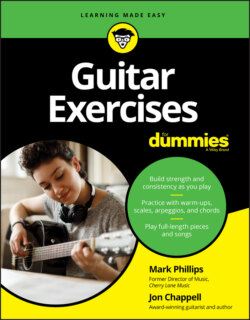Читать книгу Guitar Exercises For Dummies - Jon Chappell - Страница 5
About This Book
ОглавлениеBecause there are real physical aspects to playing guitar, we recognize that what’s true for guitar playing is also true for swimming, running, golf, or Guitar Hero: You don’t get better unless you practice. And practice, in terms of the physical conditioning we talk about here, is known as exercise. Exercise is an efficient way for your body to practice moving specific parts in the way a given activity requires. Football players lift weights to become stronger and more powerful against opponents on the gridiron. Guitar players practice scales to become more facile at playing melodies on the fretboard.
This book is a reference you can jump into and out of at will. In other words, you don’t have to read from cover to cover. Just head to the table of contents to find what you need to practice at any given moment. But it’s worth noting that we present scales, arpeggios, and chords in a logical, organized way that allows you to train your fingers and learn the musical vocabulary that comes up time and again in real-life musical situations. We explain the exercise presentation most thoroughly in Chapters 3 and 4 to get you up and playing, and then in later chapters we provide more great practice opportunities but with less commentary (we can almost hear you sighing with relief). Also notice that Chapters 3 through 12 are grouped in pairs, where the first, odd-numbered chapter in the pair introduces a new concept (such as a scale or arpeggio pattern) and the second chapter has you applying that concept in a series of exercises. Both chapters in each pair include helpful exercises, but to get the most out of these chapters and be sure you can easily follow along, you may find that it’s best to tackle these pairs starting with the odd-numbered chapter, where we take a little more time to explain things.
We think it’s also cool that all the exercises in this book are presented in movable form, which means you can move them anywhere on the neck without changing the fingering, because the pattern or form uses no open strings. A movable scale, arpeggio, or chord can be transposed to any key by simply shifting your hand up or down the neck to a different starting note and playing the same pattern. So though we present these exercises in specific keys, you can move them to any fret on the neck. We remind you of the exercises’ movability throughout the book, but we mention it here as well because it’s an important concept in understanding how this book is organized.
Finally, most chapters end with composed pieces of music that give you a chance to play what you learn in the context of making “real music.” You find these full-length practice pieces, as well as many other examples you can play along with, on the website that accompanies this book.
